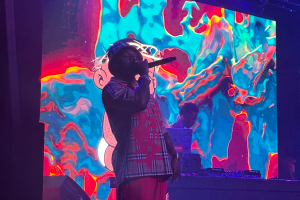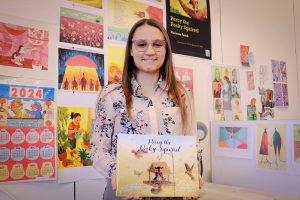Quaranzines: Tinkertoys for isolated malcontents
Quaranzines: Tinkertoys for isolated malcontents
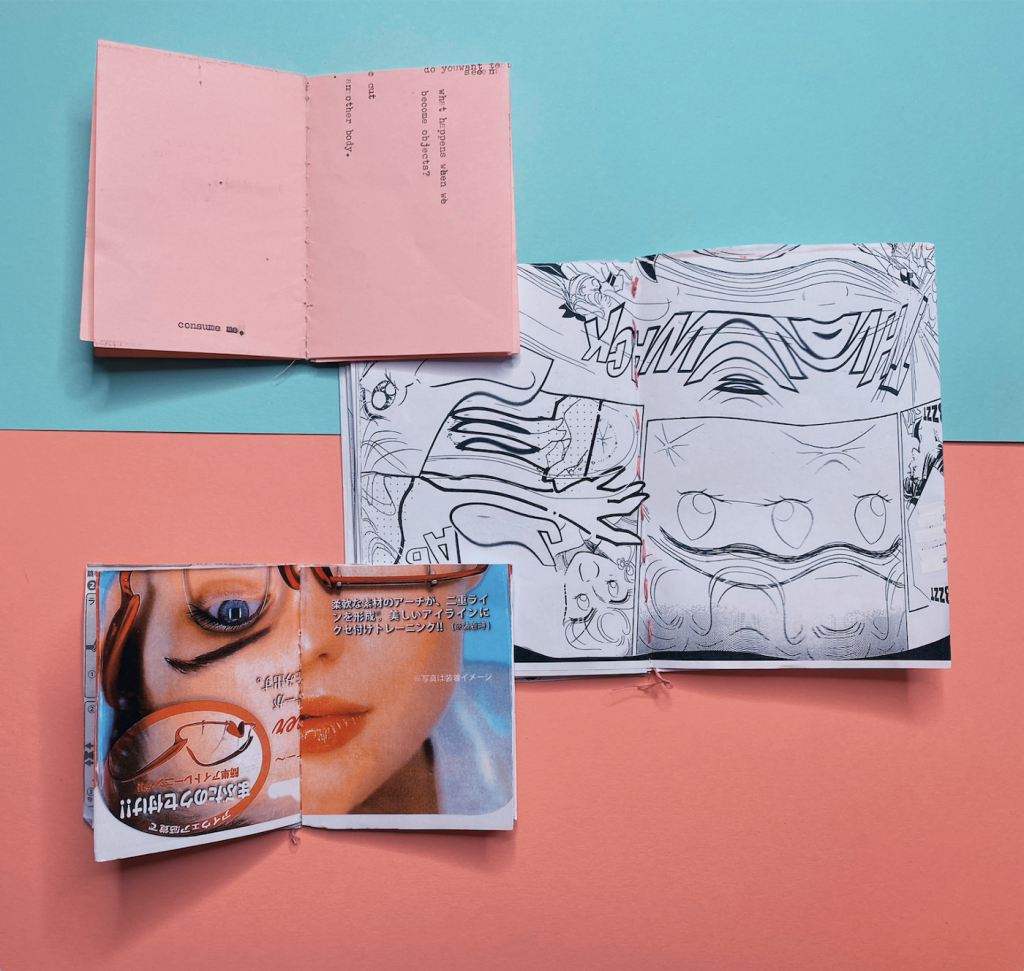
Multimedia artist Antonio C. Wright felt trapped in his apartment. With his roommates gone, the small Bushwick space weighed on his mental health. As coronavirus shutdowns began in March and his world and life paused, the apartment became more like a cell than a living space. For four months, Wright lived alone. He woke up, drank ginger tea in the morning by the windowsill, stretched, read and then repeated that ritual the next day. Those first lonely months gave Wright time to think about himself and confront things that previously escaped his notice — good habits, bad habits, likes, dislikes and unexpected emotions. “[Quarantine] started to make me feel a lot more than I was used to,” Wright said. “And the way I got it out of my body was by putting it into words.”
Wright moved from isolation’s monotony into expressing the heaviness of quarantine through art, combining the mediums of poetry, music, film and dance. “The time I had alone allowed me to try things out and fuck up, then do them well and fuck it up again three days later,” Wright said. “It gave me a sense of realness that I had never felt in my body before.” A day at the beach with his friend inspired the creation of a short film titled “F*CK” Layered with raw voiceover, Wright’s contemporary movements and a cover of the jazz standard “My Funny Valentine,” “F*CK” reflected on isolation as the point of experience and the growth of his “identity.” On a whim in July, he submitted it to the digital zine, The Pandemic Post. Soon the zine published both “F*CK” and his poem, “A Conversation on Death.” Like other quarantine zines (known as “quaranzines”), The Pandemic Post emerged as a way to express the experience of isolation and despondency created by COVID-19 and to create space to connect.
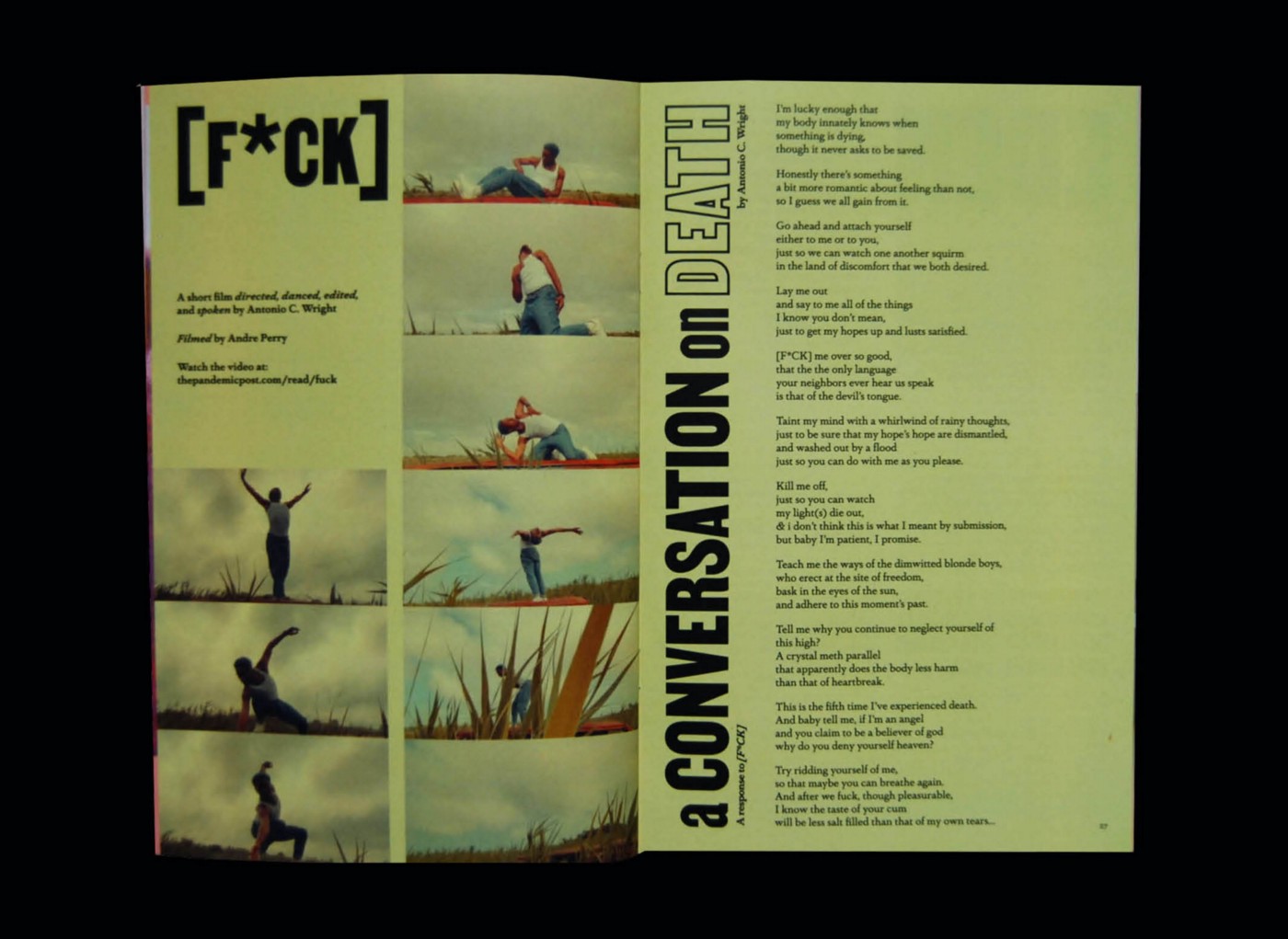
Although the inception of zines traces as far back as self-publishing, the popularization of zines is attributed to the fad of fanzines in the 1930s, the rise of punk zines in the 1970s and the riot grrrl movement in the 1990s. These communities used zines as a catalyst for resilience, strengthening relationships and to share information otherwise unsaid. Taken from the foundation of the zine, quaranzines have emerged as time capsules. Jenna Freedman, the curator of the Barnard Zine Library, found some of the quaranzines as a lens to view 2020. One of her favorites was AJ Michel’s I’ve Worn All the Shirts in the Drawer. Michel documented the mundane experience of wearing a different shirt every day with her reactions to the insanity of the pandemic. “It captures the Zeitgeist of this time which is a bit navel-gazing,” Freedman said. Outside our socially distanced, isolated lives, people were dying, our president referenced the possibility of injecting bleach to treat the virus, and PPE ran dry. Quaranzines became a daily tool to take account of the nonsense. “We’re in this bizarre river of madness, but we’re counting our T-shirts,” Freedman said. “That was such a more magical way of capturing it than just saying I’m bored.”
Quaranzines also possess a tool their zine forebearers lacked — the 21st-century tool of social media. As of December 2020, the Instagram hashtag #quaranzine boasted more than 7,800 different posts. Buried in that hashtag exist litanies of illustrations and numerous personal accounts that depict the collective consciousness fueled by the coronavirus. Anisa Rawhani, the assistant editor of Broken Pencil, a magazine about zine culture, said “people are working through their feelings around quarantine through zine-making and comic-making and really wanting to share their perspective on it.” With limited face-to-face interaction, zinesters produced both small print quaranzines and graphic-heavy digital ones. One fad that became popular was the accordion folded eight-page zine using an A4 piece of paper. It’s small, accessible and easy. Illustrator Gina McMillen adopted this zine-style as she created #100daysofzinesnstuff, a self-made spin-off of the global art project, The 100 Day Project. More than 100 zines fill the tag, albeit mostly McMillen, where she reflects and recollects on quarantine. McMillen told stories through zine titles like “Morning Thoughts,” the simple notations of living in isolation matched with illustrations of a woman drinking coffee, or “The Goldilocks Zone of 2020,” reminding us of a not-so-far-off fairytale where everything is either too close or too far.
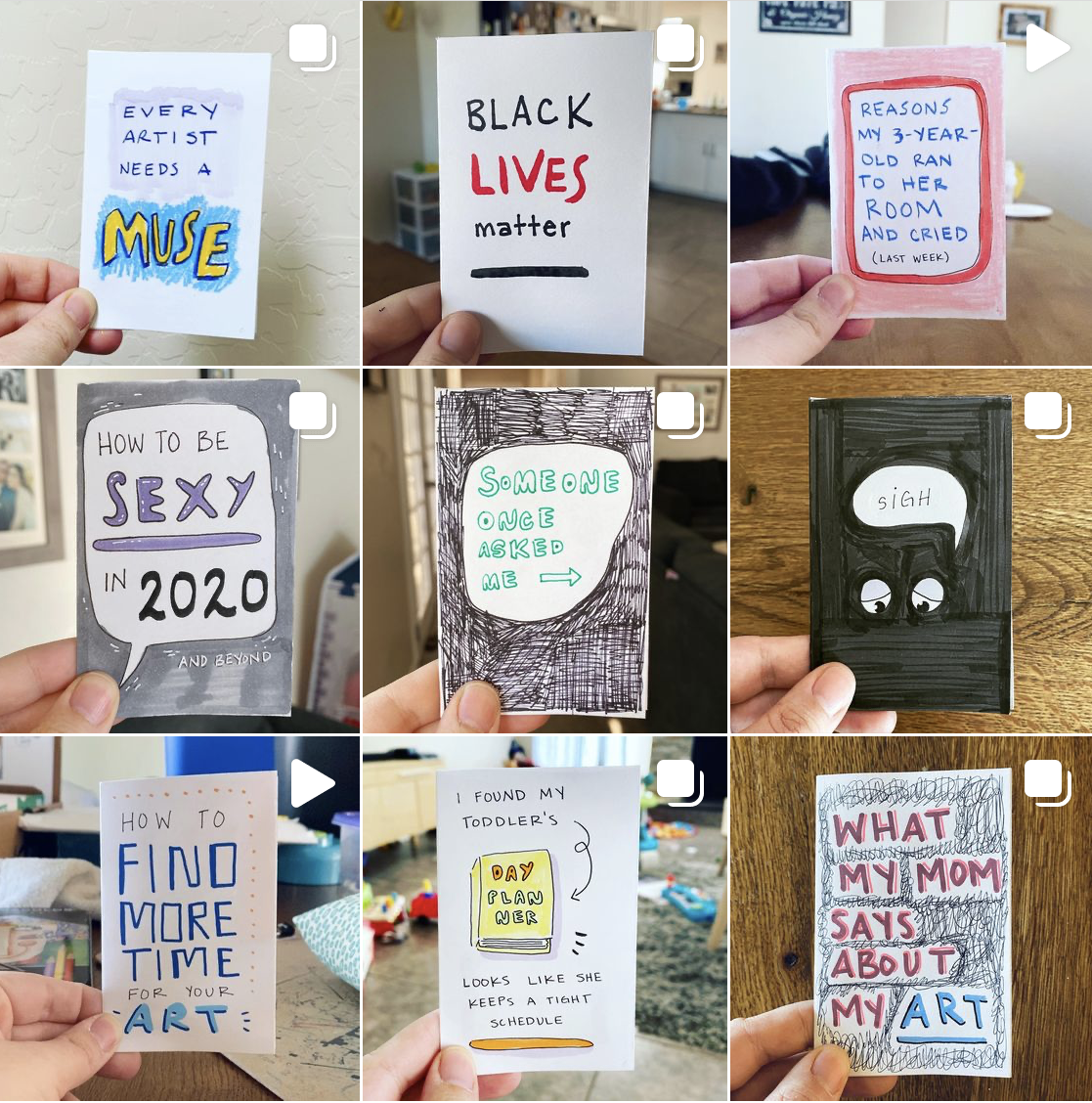
Given the nature of 2020, quaranzine-making workshops, like everything else in life, transported online. The hands-on style of zine-making, whether with the A4 folding method, or larger zines, allowed individuals to share in community and finish something small. Artist Ambie Drew held a Zoom quaranzine-making workshop with Stryx Gallery, in Birmingham, U.K. as part of her art residency. Drew decided she wanted to have an interactive exhibit where accessibility was key. “[The gallery and I] wanted to integrate a workshop in so that the public could easily access it,” she said. “That meant that anyone who, unlike me doesn’t just have all this stuff, could join in and make something with us.” Using only paper, scissors, and a pen, anyone could make a quaranzine.
Malaka Gharib, bona fide zinester and deputy editor and digital strategist of NPR’s Global Health and Development team, hosted a handful of zine-making workshops throughout quarantine. With Believer Magazine, Gharib found that the combination of community and the act of completion, even with something as small as a zine, helped. “I think that people love to do it in community and know they can finish something within a time constraint,” Gharib said, “especially during a time where it seems like you can’t control anything.”
The accessibility of digital graphics also helped fuel the creation and popularity of quaranzine-making. The Pandemic Post, a digital and print zine made “by and for 2020,” used graphics to represent the nostalgic feel of a newsletter. Dash Robb and sisters Kate and Lucy Andersen founded The Pandemic Post to help raise money for organizations struggling with the economic and social impacts of COVID-19. Biohazard yellow, the traditional cut-and-paste zine aesthetic, old-timey fonts and a traditional hardcopy newspaper emphasized the experience of quaranzines as a time capsule. “The idea of a pandemic felt dated,” Lucy said. “When you think of the original format of [a 1918] newspaper — this big broadside was a part of an ongoing thread of throwback vintage.”
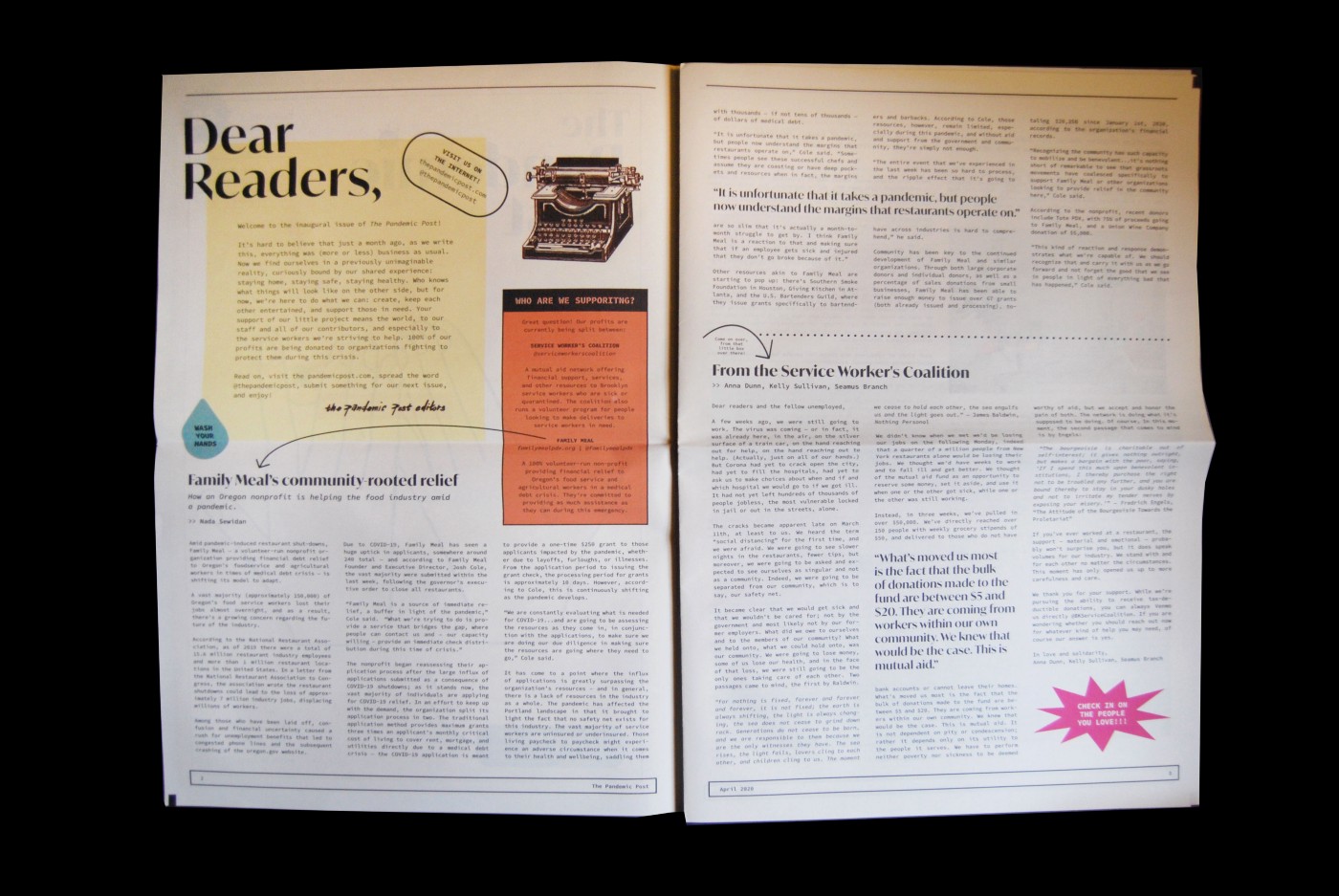
Other organizations like the Asian American Feminist Collective who published Asian American Feminist Antibodies, a zine dedicated to unpacking and dismantling the xenophobic language and experiences of Asians in the United States during COVID-19, relied heavily on digital graphics. The nature of isolation required quaranzines to be shared digitally whether or not they were designed that way. And the internet-fueled the sharing while pushing the publications to evolve to submission-based, community quaranzines.
Similar to the charity that inspired the creators of The Pandemic Post, Emilie Wilde, artist, and co-creator of Quaranzine!, a digital zine made by artists for artists, wanted to support struggling artists like herself. Wilde found that during quarantine her friends and colleagues longed to connect with other artists. Wilde and Pat Dawson, co-creator and colleague of Wilde’s, saw Quaranzine! as a way to provide a forum for the now “bedroom artists,” a Wilde-coined-term. Dawson asked: “Now that everyone’s already in their bedrooms because of quarantine, how do we spread [their work] around?” Under their direction, the digital space of “QZ,” Wilde’s nickname for the project, became the answer, transforming into a community and support system for artists.
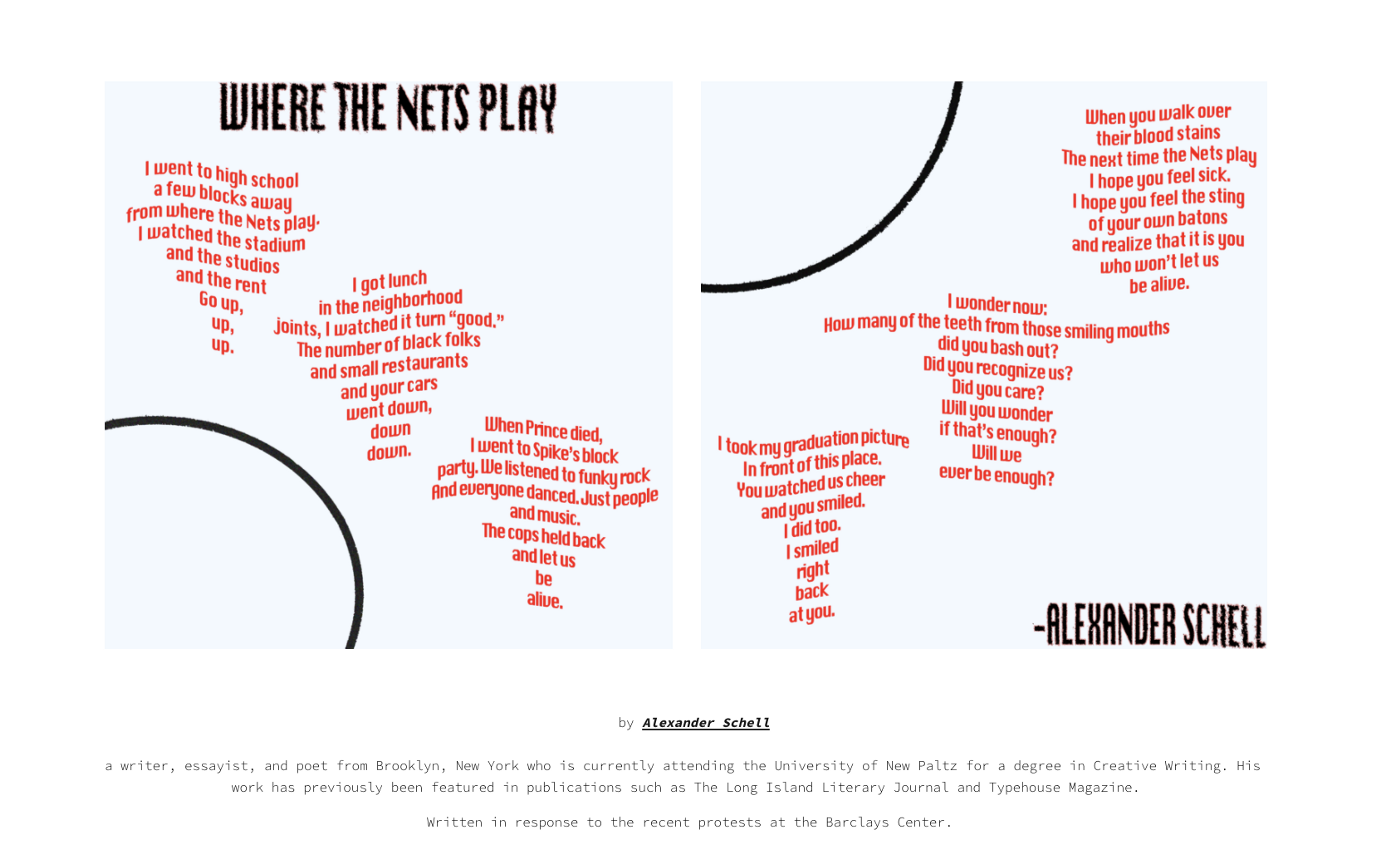
Zines of previous generations often existed as found objects and surprises — imaginative creations left on a bench, inside a book for some mysterious, unknown future reader to find, discover and enjoy. Quaranzines offer creators, artists, and readers a much more intimate and connected experience. For both those who publish the quaranzines and the artists who submit work, these publications have become a community-building gratitude loop. Wilde recalls waking up to emails from 16-year-old girls in Ireland, presenting their poems, sharing their stories, and ecstatic to see their work published. “[We] want to give their art the respect that it deserves and give them the respect they deserve,” Wilde said. “For some reason, in the art community, it’s rare to have a space where the people who are creating these platforms are actually grateful for the artists who submit.”
The creators of The Pandemic Post wanted to provide a physical product in return for donations for those struggling to navigate the economic impacts of the pandemic. Helping the surrounding community served as the initial goal, but the project evolved into a space for creators too. Individuals, like Wright, could share their quarantine emotions and see their work published. “The last issue we got so many people writing back saying, ‘What a thrill to see my work published, this is so beautiful,’” Kate said. Although The Pandemic Post began as a very “2020 publication,” it remains to be seen if it will evolve into a “post-Pandemic Post.” But, as 2021 looms, fans and those in need of a creative outlet should feel a bit of relief. “We’re gonna keep doing it as long as we have time and feel like there is a need,” Kate said.



